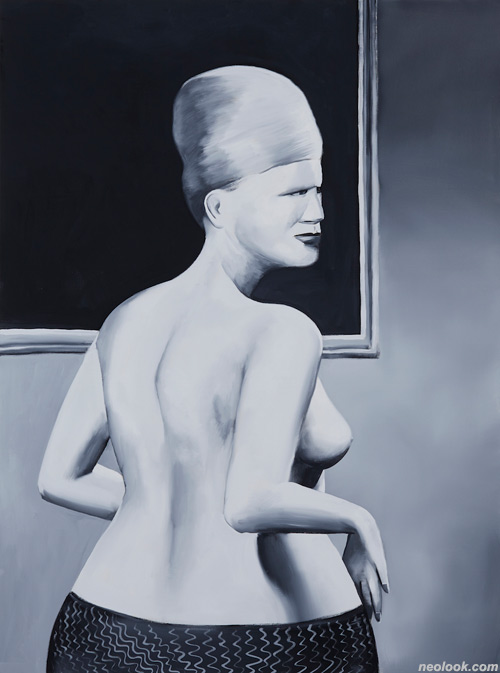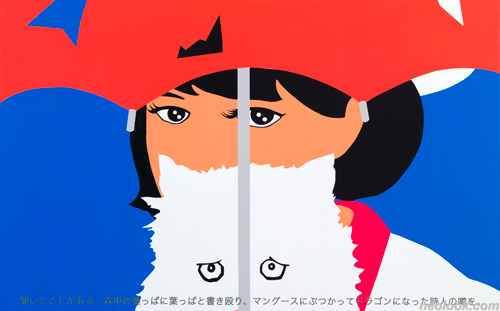- ● homepage
- ● archives
- ● restoration
- ● books
- ● big banners
- ● post board
- ■ neo's search
- ■ about us
- ■ 게재방법 안내
- 개인정보처리방침

- [email protected]
- Tel. 02_335_7922
- Fax. 02_335_7929
- 10:00am~04:30pm
- 월요일~금요일
- 3/3(월) 대체공휴일

경계의 편재
THE UBIQUITY OF BORDERS : JAPANESE CONTEMPORARY展 2018_0207 ▶ 2018_0310 / 일,월요일 휴관

- 토무 고키타TOMOO GOKITA_"Why?"_acrylic gouache on canvas_130×97cm_2017 © Tomoo Gokita, Courtesy of Taka Ishii Gallery, Photo by Kenji Takahashi
초대일시 / 2018_0207_수요일_06:00pm
참여작가 토무 고키타Tomoo Gokita_이즈미 카토Izumi Kato 타츠오 미야지마Tatsuo Miyajima_다이스케 오바Daisuke Ohba 미카 타지마Mika Tajima_소즈 타오Soju Tao_히로후미 토야마Hirofumi Toyama
관람시간 / 10:00am~06:00pm / 일,월요일 휴관
갤러리바톤 GALLERY BATON 서울 강남구 압구정로29길 65 Tel. +82.(0)2.597.5701 www.gallerybaton.com
갤러리 바톤은 2월 7일부터 3월 10일까지 압구정동 전시공간에서 일본 현대미술가 7인이 참가하는 경계의 편재(The Ubiquity of Borders: Japanese Contemporary)전을 개최한다. 이 전시는 일본을 넘어 국제무대에서 공감대를 얻은 현대미술가 토무 고키타, 이즈미 카토, 타츠오 미야지마, 다이스케 오바, 미카 타지마, 소즈 타오, 히로후미 토야마의 다양한 작품을 선보이는 자리다. ● '경계의 편재(The Ubiquity of Borders)'는 사와라기 노이(椹木野衣)가 쓴 『일본·현대·미술』(2012)의 '제6장 바리케이트 속의 포스트 모던'에 등장하는 개념이다. 전시는 "현대 일본에서 경계선이라는 개념은 복합화, 투명화, 편재화했다"는 저자의 언급에서 출발했다. 참여작가는 회화와 디지털 미디어라는 전통과 현대의 양극에 있는 매체로 작업하며 평면과 공간, 현실과 가상을 유연하게 넘나든다. 그 과정에서 매체의 고유성은 잃지 않으면서도 두 매체 사이 경계를 자유롭게 오간다. ● 서구 지역이 냉전 질서를 수립하고 근대화를 추진함에 따라 세계는 이원적인 경계로 나뉘었다. 아시아에서 가장 빠르게 근대화를 이룩한 일본은 자국과 서구, 전통과 근대의 충돌과 공존을 받아들였다. 서구 매체를 습득하면서도 전통적 일본 미술의 정신성을 오롯이 지키고자 한 당시 예술가의 태도는 1950~70년대 구타이 운동과 모노하 운동으로 이어졌다. 1980년대 이후 일본의 젊은 예술사는 글로벌 아트 신에서 일본 현대미술의 우수성을 정립하는 데 크게 역할을 할 뿐 아니라 포스트모더니즘을 하이테크놀로지를 등에 업은 새로운 미디어의 등장을 온몸으로 흡수했다. 내면적으로는 서구와 동시대적 공감대는 유지하면서도 표면적으로는 자국의 전통에 기반한 이질적인 이미지를 선보인 일본 예술가들의 미감은 국제적인 반향을 일으켰다.

- 타츠오 미야지마TATSUO MIYAJIMA_Counter Spiral No.14_ LED (132 green LED), IC, electric wire, transformer, metal panel, etc_310×61cm_2000 ⓒ photo by Daichi Ano

- 다이스케 오바DAISUKE OHBA_6_acrylic on cotton_120×120cm_2017 © photo by Nobutada Omote
토무 고키타(Tomoo Gokita, b. 1969)는 1960~70년대 사진이나 잡지에서 발췌한 인물 이미지의 얼굴을 변형해 모노톤의 추상적인 패턴을 만든다. 1990년대부터 유기체적인 형상을 드러내는 회화와 조각을 선보인 이즈미 카토(Izumi Kato, b. 1969)는 구상 회화를 근간에 두지만 직접 손으로 안료를 발라 만든 독특한 마티에르를 선보인다. 타츠오 미야지마(Tatsuo Miyajima, b. 1957)는 디지털 매체를 활용해 삶과 죽음, 시간의 순환에 대한 근원적인 질문을 던진다. 이번 전시에선 기하학적이면서도 유기적인 나선형의 구조를 드러낸 'Counter Spiral'을 선보인다. 관람자가 바라보는 각도에 따라 색채가 달라지는 회화를 선보이는 다이스케 오바(Daisuke Ohba, b. 1981)는 홀로그램 안료를 사용해 색채 스펙트럼을 넓힌다. 미카 타지마(Mika Tajima, b. 1975)는 디지털 미디어, 사운드, 설치, 디자인 장르를 오가며, 산업 사회에서 정보화 사회로 이어지는 동시대 이슈를 드러낸다. 소즈 타오(Soju Tao, b. 1977)는 직접 만든 노래와 시에서 따온 텍스트를 얹은 회화를 선보인다. 마지막으로 히로후미 토야마(Hirofumi Toyama, b. 1967)는 수평과 수직을 오가는 선과 색면으로 정제된 화면을 만들어, 캔버스 위 여백을 전시장 벽으로 연결해 회화를 공간의 영역으로 확장한다. ● 일본의 미술은 높은 경제력과 서구의 오랜 문화적 영향력에 기반한 문화적 특수성, 다양한 깊이와 내러티브를 지닌 주요 예술가를 다수 배출해냈다. 하지만 국제적인 위상을 높인 이들의 뛰어난 활약에 비해, 한국의 관심은 상업적으로 성공을 거둔 일부 작가에만 편향돼 있다. 『경계의 편재』전은 그동안 우리가 간과했을지 모르는 주요한 일본 현대 미술가에 대한 담론을 형성하고자 한다. 이번 전시가 일본 현대미술이 재패니즈 팝과 서브 컬처에만 치중됐다는 선입견을 씻어내고, 그 속의 진정한 가치를 들여다보는 매개체 역할을 하길 바란다. ■ 갤러리바톤

- 미카 타지마MIKA TAJIMA_Negative Entropy (Toyota Motomachi, Magenta, hex)_ cotton, wood, acoustic baffling felt_285×150cm_2015 ©Mika Tajima, Courtesy of TARO NASU, Photo by Keizo Kioku

- 소즈 타오SOJU TAO_Rumors_acrylic and silkscreen on canvas_73×117cm_2014 © Soju Tao, Courtesy of Take Ninagawa, Tokyo, Photo by Kei Okano
Gallery Baton is pleased to present, 'The Ubiquity of Borders: Japanese Contemporary,' an exhibition of works by internationally renowned Japanese artists: Tomoo Gokita, Izumi Kato, Tatsuo Miyajima, Daisuke Ohba, Mika Tajima, Soju Tao, and Hirofumi Toyama. ● Since the '90s, various groups of Japanese artists have been placed in complex situations as they experienced changes in Japan's social, cultural and economic climate. Artists have been influenced by the diversification of values, the turn toward globalization, the development of new technologies, and the foundation of post-modernism. Also, Japan's retrenchment led artists to seek opportunities overseas. Artists entered into contemporary conversations with the West while continuing to search within for individual spirituality and upholding characteristics of the Japanese culture that they closely identified with. ● The exhibition introduces seven artists who explore various media—from painting to digital technology—as new pathways for creation. While maintaining the inherent characteristic of each medium, the artists' works challenge the instrumental limits and conceptually and perceptually traverse between boundaries. If the physical and practical barriers indicate a state of denial and tension, the artists in the exhibition confront reality through transparent and impermanent barriers. ● Tomoo Gokita (b. 1969) creates abstract monotone patterns by transforming the faces of figures selected from photographs and magazines of the '60s and '70s. Izumi Kato (b. 1969) creates organically configured paintings and sculptures, often applying pigments directly with his hands to layer and heighten the materiality of his work. Tatsuo Miyajima (b. 1957) uses digital media to address questions of life, death, and the passage of time. Daisuke Ohba's (b. 1981) paintings convey subtle color changes through the use of hologram pigments. Mika Tajima (b. 1975) uses digital media, sound, installation, and design to investigate issues of our contemporary era that stems from the transformation of an industrial to an information society. Soju Tao (b. 1977) presents paintings paired with texts from self-authored poems and lyrics, and Hirofumi Toyama (b. 1967) creates intricate paintings of composed of intersecting lines. Toyama extends the space beyond the edges of the canvas by perceptually connecting the spaces in one painting to another painting. ● Japan has produced many major artists who are active in the contemporary art world today. Embedded with a deep history and cultural background, these seven artists create works that are rich with complex visual narratives. Through this unique exhibition, Gallery Baton hopes to recognize the rising talents that continue to connect and transverse between boundaries. Tatsuo Miyajima, one of the participating artists, emphasizes three principles that encapsulate the central message of the exhibition: "Keep Changing, Connect Everything, Continue Forever." ■ GALLERY BATON
Vol.20180207f | 경계의 편재-THE UBIQUITY OF BORDERS : JAPANESE CONTEMPORARY展
